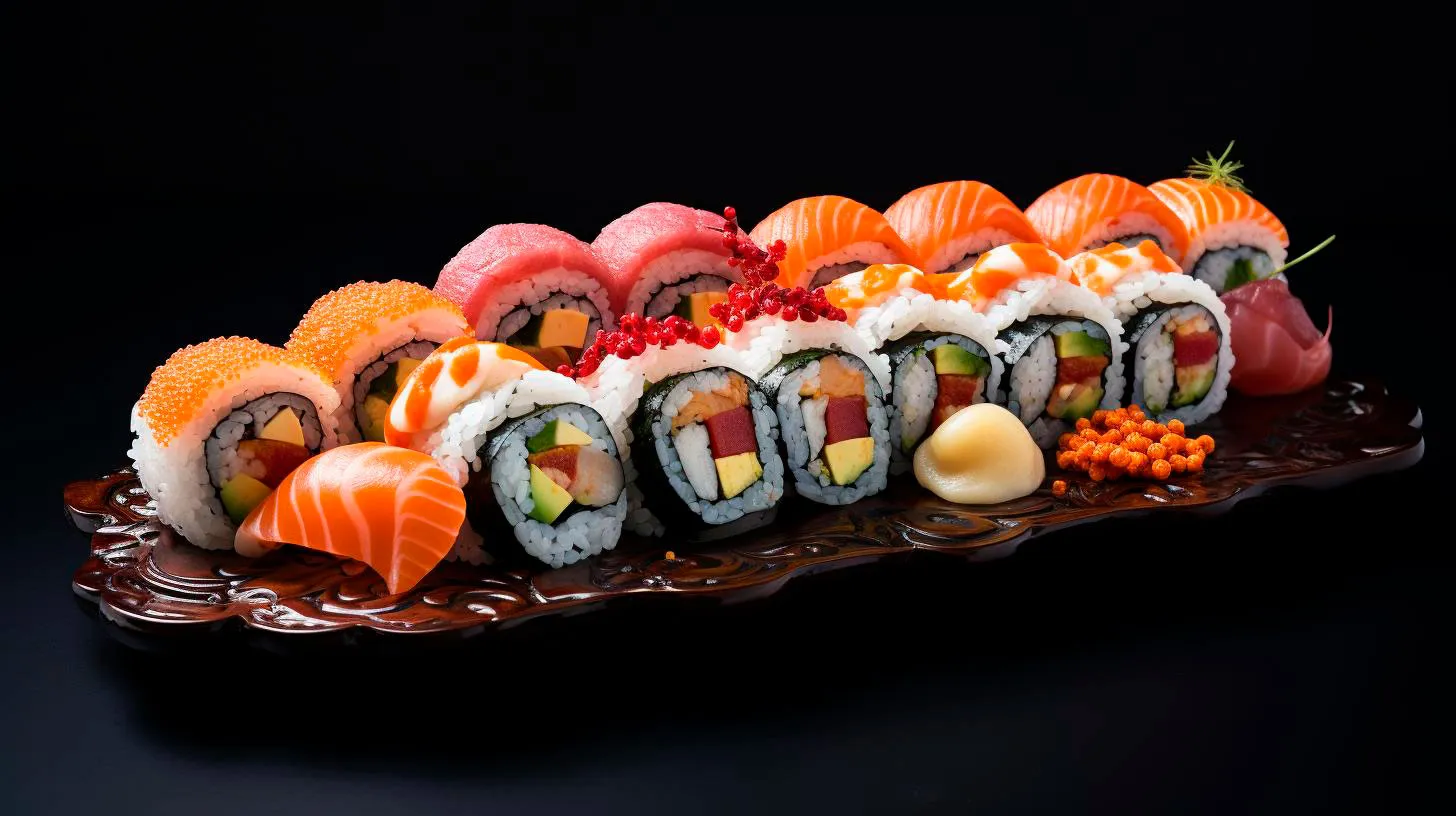Exploring Global Influences: How Sushi Adapted Around the World
The Origins of Sushi
Before we dive into the global influence on sushi, it’s essential to understand its origins. Sushi dates back to the 8th century in Southeast Asia, where fish was traditionally stored in fermented rice to preserve it during the process of lacto-fermentation. This technique spread to Japan, where it went through further developments and became what we now know as sushi.
Sushi in Japan: Edo-Mae Style
In Japan, sushi went through significant culinary advancements during the Edo period (1603-1868). During this time, the Edo-Mae style of sushi emerged, which involved serving raw seafood over vinegar-seasoned rice. The focus was on highlighting the freshness and natural flavors of the ingredients.
While traditional sushi was primarily enjoyed by the upper class and was considered a luxury food, it eventually became more accessible to the general public. The advent of refrigeration techniques and the establishment of sushi stalls by street vendors played a crucial role in popularizing sushi.
The Influence of America
Moving away from Japan, we can see the significant influence of America on sushi. It was in the mid-20th century that sushi first made its way to the United States, primarily through Japanese immigrants.
Initially, traditional sushi faced resistance due to raw fish being unfamiliar to the American palate. This led to the introduction of the California roll, a maki roll with avocado, cucumber, and crab meat. The idea behind this creation was to make sushi more approachable, catering to the preferences of Western consumers.
The California roll’s success paved the way for further experimentation with sushi. Fusion rolls containing ingredients like cream cheese, tempura, and spicy sauces became popular, blending Japanese flavors with American influences. This adaptation allowed sushi to appeal to a wider audience and gradually led to its mainstream acceptance.
The Rise of Sushi Chains
In recent years, sushi has gained even more popularity through the rise of sushi chains. These chains have taken the concept of sushi and made it more accessible and affordable for the masses. Some well-known sushi chains have established a global presence, offering standardized sushi experiences and attracting customers with their diverse menu options.
Advantages of sushi chains include:
- Consistent quality and taste across various locations
- A wide range of sushi options, catering to different dietary preferences
- Affordability without compromising taste
Sushi goes International
As sushi made its way across different continents, unique variations and adaptations emerged to cater to local tastes and ingredients.
European Influences
In Europe, sushi has integrated with local cuisines, resulting in creative fusions. A notable example is the Nordic-inspired sushi, where traditional ingredients are replaced with local seafood like salmon and pickled herring. This adaptation appeals to European palates while incorporating the essence of sushi.
Key Takeaways:
- Sushi adapts to local tastes and ingredients in Europe
- Nordic-inspired sushi showcases regional seafood flavors
Latin American Influences
In Latin America, sushi has received influences from local ingredients and flavors, resulting in vibrant and diverse creations. Examples include sushi rolls with tropical fruits like mango and passion fruit, as well as the use of popular Latin American condiments such as chimichurri and chipotle mayo.
Key Takeaways:
- Tropical fruits add a refreshing twist to Latin American sushi
- Local condiments inject Latin American flavors into sushi rolls
Asian Influences
In Asia itself, sushi has had different adaptations to fit regional palates. For instance, in Southeast Asia, sushi has been infused with spicy and tangy flavors, creating a fusion of Japanese and local cuisines. Additionally, countries like China and Korea have developed their own sushi variations that reflect their culinary traditions.
Key Takeaways:
- Spicy and tangy flavors dominate sushi in Southeast Asia
- China and Korea have their unique sushi variations
The Future of Sushi
The global influence on sushi has undoubtedly shaped its journey, making it a beloved dish worldwide. As sushi continues to evolve, we can anticipate further fusion and adaptation to suit changing culinary preferences and market demands.
Key Takeaways:
- Sushi will likely continue to fuse with local cuisines
- Further experimentation and innovation within sushi are expected
In conclusion, sushi’s ability to adapt and evolve has allowed it to transcend geographical boundaries. From the traditional Edo-Mae style to fusion rolls and regional adaptations, sushi has truly become a global culinary phenomenon. So, the next time you indulge in a sushi roll, consider the fascinating journey it undertook to reach your plate!
Evolution and Innovation: Sushi Journey into Modern Times
The Origins of Sushi
Before diving into the modern sushi landscape, let’s take a moment to appreciate its humble beginnings. Sushi originated in Southeast Asia, where fish was fermented with rice to preserve it. This ancient preservation method gradually made its way to Japan, where it developed into a unique culinary art form.
The first sushi in Japan was made by wrapping fermented fish with rice, but it wasn’t until the 19th century that Edo-style sushi became popular. Edo-style sushi, named after the old name of Tokyo, introduced vinegared rice, allowing the fish to be consumed immediately, without the need for fermentation.
The Evolution of Sushi
As sushi gained popularity in Japan, it started to undergo numerous transformations, both in terms of ingredients and presentation. Here are some key developments that have shaped the modern sushi we know today:
1. Nigiri Sushi:
- Nigiri sushi, also known as hand-pressed sushi, became popular during the 19th century. It consists of a small mound of vinegared rice topped with a slice of raw or cooked fish.
- The introduction of soy sauce and wasabi as accompaniments enhanced the flavors of nigiri sushi.
2. Maki Sushi:
- Maki sushi, or rolled sushi, is made by wrapping fish, vegetables, or other ingredients in seaweed (nori) and rice.
- These bite-sized rolls became increasingly popular in the early 20th century and are now a staple in sushi menus worldwide.
3. Sashimi:
- Sashimi refers to thin slices of raw fish or seafood served without rice.
- While not technically sushi, sashimi is often enjoyed alongside sushi dishes and has become a beloved delicacy around the globe.
The Innovation in Sushi
In recent years, sushi has experienced a wave of innovation, pushing its boundaries and surprising taste enthusiasts. Contemporary sushi chefs are constantly exploring new ingredients, techniques, and presentation styles, leading to the emergence of fusion sushi and creative variations.
1. Fusion Sushi:
- Fusion sushi combines traditional Japanese sushi with ingredients and flavors from other cuisines, such as Mexican, Italian, or even Hawaiian.
- Examples include sushi rolls with spicy tuna, cream cheese, and avocado or sushi topped with unique sauces like mango or eel sauce.
2. Vegetarian and Vegan Sushi:
- Responding to the growing demand for plant-based alternatives, sushi chefs have started creating innovative vegetarian and vegan sushi.
- Ingredients like tofu, avocado, sweet potato, and various vegetables are skillfully combined to offer a delightful and cruelty-free sushi experience.
3. Molecular Gastronomy in Sushi:
- Molecular gastronomy techniques have also found their way into the world of sushi.
- Using tools like liquid nitrogen, chefs can create unique textures and flavors, pushing the boundaries of what sushi can be.
The Advantages of Modern Sushi
The evolution and innovation in sushi have brought several advantages that contribute to its enduring popularity:
1. Accessibility:
- Sushi is now widely available around the world, making it easy for people to indulge in this delicious cuisine no matter where they are.
- It has become a mainstream option on menus, including in non-Japanese restaurants.
2. Health Benefits:
- Sushi is generally considered a healthy option as it often includes lean proteins, omega-3 fatty acids, and nutrient-rich vegetables.
- Consuming raw fish also offers various health benefits, including boosting brain health and reducing the risk of heart disease.
3. Culinary Experience:
- With its beautiful presentation and diverse flavors, sushi provides a unique culinary experience that can be enjoyed by food enthusiasts and novices alike.
Key Takeaways
Sushi has come a long way from its humble origins. It has not only evolved to become more accessible but has also embraced innovation to cater to different tastes and dietary preferences. The journey of sushi into modern times has brought numerous advantages, including health benefits and an exciting culinary experience. Whether you prefer traditional nigiri or enjoy exploring fusion creations, sushi continues to be a beloved and ever-evolving cuisine that appeals to a global audience.
From Traditional to Fusion: Exciting Twists on Sushi Recipes
However, in recent years, a new trend has emerged in the world of sushi – fusion creations that put an exciting spin on traditional recipes.
The Rise of Fusion Sushi
Fusion cuisine is the art of combining different culinary traditions and techniques to create innovative and unique flavors. This concept has made its way into the sushi world, resulting in a delightful fusion of Japanese and international ingredients. Chefs are experimenting with various ingredients and cultural influences to create fusion sushi rolls that are not only visually stunning but also bursting with unexpected flavors.
Types of Fusion Sushi
Here are some exciting twists on traditional sushi recipes that will surely tickle your taste buds:
- Mexican-inspired rolls: Combine the flavors of Japan and Mexico by using ingredients such as avocado, jalapenos, and cilantro. The creamy texture of avocado pairs perfectly with the freshness of sushi rice, creating a delectable combination.
- Hawaiian-style poke rolls: Poke, a popular Hawaiian dish, typically consists of marinated raw fish served over rice. Transform this into a sushi roll by wrapping the marinated fish in seaweed with rice and other accompaniments. It’s a tropical twist that will transport you to the beautiful shores of Hawaii.
- Tempura rolls: Tempura is a Japanese cooking technique that involves deep-frying seafood or vegetables in a light batter. Incorporating this crispy delight into sushi rolls adds a delightful crunch and elevates the overall flavor profile.
- Teriyaki chicken rolls: Teriyaki is a beloved Japanese sauce made from soy sauce, mirin, and sugar. By adding teriyaki-glazed chicken to your sushi rolls along with fresh vegetables, you can enjoy the perfect balance of sweet and savory flavors.
- Indian-inspired sushi: Infuse a touch of India into your sushi by incorporating flavorful spices like curry powder or using ingredients like paneer (Indian cottage cheese). These unique combinations create a fusion of Indian and Japanese cuisines.
The Advantages of Fusion Sushi
Wondering why you should give fusion sushi a try? Here are some advantages that might convince you:
- Exploring new flavors: Fusion sushi introduces you to an array of exciting flavors and unexpected combinations. It’s an opportunity to experience the best of both worlds as different cultures and ingredients come together harmoniously.
- Unleashing creativity: With fusion sushi, the possibilities are endless. Chefs and home cooks alike can let their imaginations run wild, experimenting with various ingredients, flavors, and presentations to create visually stunning and delicious rolls that will impress even the most discerning palate.
- Catering to diverse palates: Fusion sushi caters to a wide range of palates by offering something for everyone. Whether you prefer bold and spicy flavors or a delicate and subtle taste, there is a fusion sushi roll out there waiting to satisfy your cravings.
Key Takeaways
Fusion sushi is an exciting culinary trend that brings together the best of traditional Japanese cuisine with influences from around the world. By experimenting with flavors and techniques, chefs have created a whole new realm of sushi that is as visually stunning as it is delicious.
Next time you find yourself at a sushi restaurant or in your own kitchen, consider trying a fusion sushi roll. These innovative creations provide a unique twist on traditional recipes, allowing you to explore new flavors and unleash your creativity. With fusion sushi, you can embark on a gastronomic adventure that combines the familiar and the unexpected, resulting in a truly memorable dining experience.
Unraveling the Origins: Tracing Sushi’s Ancient Beginnings
The Birth of Sushi: A Culinary Evolution
Let’s start by dispelling a common myth – sushi did not originate in Japan. Its roots can be traced back to Southeast Asia, where ancient cultures developed techniques to preserve fish using fermented rice. The need for preservation arose due to the absence of refrigeration in those times, making it crucial to find alternative methods to store fish.
The sushi we know today began to take shape in the 8th century, during Japan’s Heian period. “Narezushi,” the predecessor of modern sushi, emerged as a means to ferment fish and rice together. This technique included layers of fish and rice packed tightly in wooden barrels and left to ferment for several months.
Throughout the centuries, sushi continued to evolve into various forms, with each region adding its own twist. In the Edo period (1603-1868), sushi became more accessible to the general public as street vendors began selling it. This era also witnessed the birth of “nigiri sushi,” which we still enjoy today – a small mound of vinegared rice topped with a slice of fresh fish.
Types of Sushi and Their Uniqueness
Sushi has transcended borders and developed its own distinct variations. Let’s explore some of the most popular types:
1. Nigiri Sushi:
Nigiri sushi is a bite-sized delight consisting of a small oblong mound of sushi rice topped with a slice of raw or cooked fish, shrimp, or other seafood. This classic style is often served with a dab of wasabi between the rice and the fish.
2. Maki Sushi:
The iconic sushi roll, maki sushi, features a seaweed wrapper called nori, which is filled with sushi rice, fish, vegetables, or other ingredients. It is then rolled tightly and cut into bite-sized pieces. Maki offers endless possibilities for flavor combinations and is a favorite for sushi enthusiasts.
3. Sashimi:
Sashimi, although not technically sushi, is a popular Japanese dish often enjoyed alongside sushi. It consists of thinly sliced raw fish or seafood served without rice. The focus here is on the quality of the fish, allowing the delicate flavors to shine.
4. Temaki Sushi:
Temaki sushi, also known as a hand roll, is a cone-shaped sushi roll with a nori seaweed wrap. It contains a variety of fillings such as fish, rice, vegetables, and sauces. Temaki sushi offers a fun and interactive dining experience as it is typically enjoyed by hand.
Key Takeaways: From Ancient Tradition to Worldwide Phenomenon
Sushi’s journey from its humble roots to a global sensation is a testament to its irresistible flavors and versatility. Let’s summarize the key takeaways from our exploration:
- Sushi originated in Southeast Asia as a method to preserve fish using fermented rice.
- The predecessor of modern sushi, “narezushi,” emerged in Japan during the Heian period.
- During the Edo period, sushi became more accessible and evolved into nigiri sushi, the foundation of contemporary sushi.
- Nigiri sushi, maki sushi, sashimi, and temaki sushi are among the most popular variations enjoyed worldwide.
- Each type of sushi offers a unique dining experience, filling your taste buds with a delightful array of flavors.
In conclusion, sushi’s ancient origins and the subsequent culinary evolution are a testament to its reign as one of the most beloved dishes around the world. Whether you’re indulging in a traditional nigiri sushi or savoring the vibrant flavors of a maki roll, each bite unravels a profound cultural history tied to this iconic cuisine.


